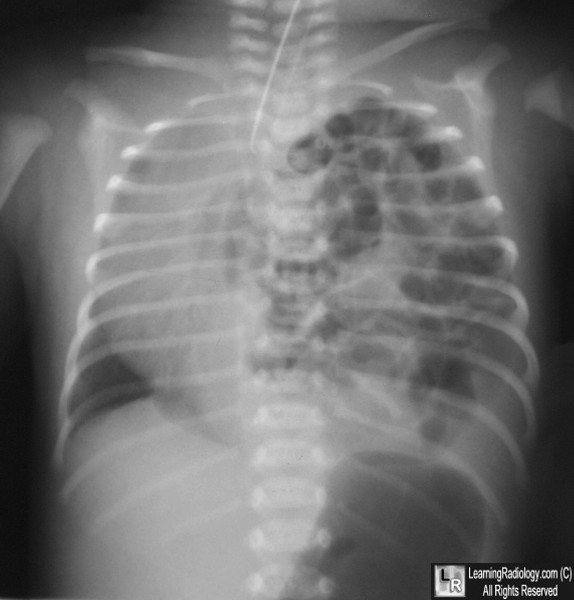|
|
Congenital Diaphragmatic Hernia
General Considerations
- If striated muscle layer doesn't form
- If defective development, diaphragmatic hernia develops
- Anterior – Morgagni
- Usually not large
- Usually unilateral
- Medial and basal
- Posterior – Bochdalek
- Most common
- Occurs through old pleuroperitoneal canals
- Just lateral to the spine on either side
- More frequent on left side
- Possibly due to “protection” of right-side by liver
- Hernia may contain intestine, stomach, spleen, liver or omentum
- If hernia occurs on right
- Intestine and liver or only liver may herniate
- If the defect is large, newborns usually present with
- Severe respiratory distress
- Cyanosis
- Scaphoid abdomen
- Some part of diaphragm is usually found at surgery, even if defect is very large
- Hypoplasia of ipsilateral lung occurs from mass effect of bowel
- Most often these are isolated congenital abnormalities
- Can have
- CHD
- 13 ribs
- Malrotation of GI tract is almost always present
- Imaging findings
- Initially, hemithorax may appear opaque because loops are fluid-filled
- Paucity of bowel loops beneath the diaphragm
- Once air swallowing begins, multiple lucencies contained within bowel are seen
- Respiratory distress may increase as intestine occupies more space
- Some loops may remain fluid-filled
- Mediastinal shift to the opposite side
- Relative paucity of gas in abdomen
- If stomach remains in abdomen, more centrally located than normal
- Contrast through an NGT is diagnostic
- Differential diagnosis of lucent cysts in infant lung
- Cystic adenomatoid malformation
- Staphylococcal pneumonia
- In both, abdomen contains normal amount of air-filled loops
- Delayed herniation of bowel may occur in older infants following streptococcal pneumonia
- Mortality around 50%
- Pulmonary hypoplasia
- Persistent Fetal Circulation Syndrome
- Treatment
- Surgical repair
- Many demonstrate ipsilateral pulmonary hypoplasia for years after repair
- Obstructive emphysema in either lower lobe

Congenital Absence of the Diaphragm. There are multiple loops of small bowel occupying the left hemithorax because of absence of the left hemidiaphragm. The heart is pushed to the right.
|
|
|